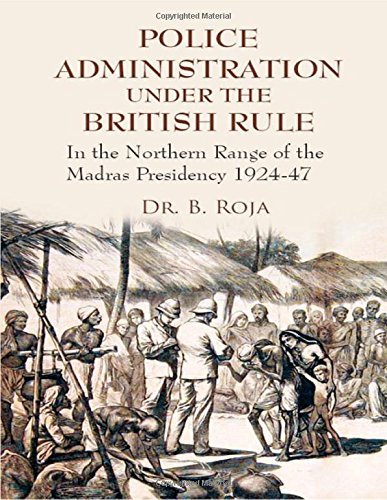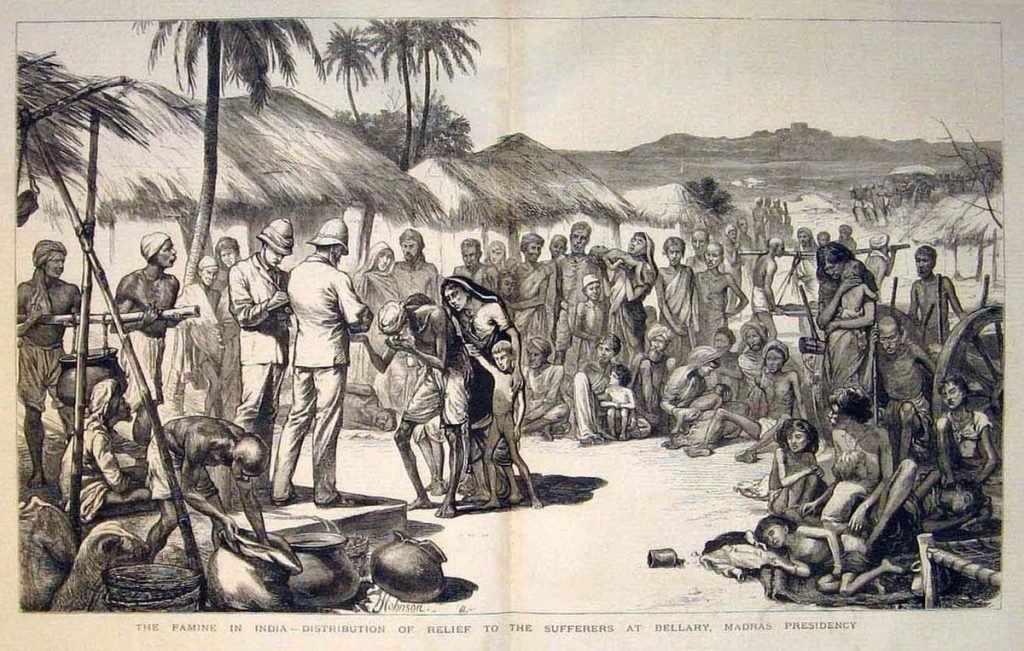
The Northern range was one of the police divisions of the erstwhile Madras Presidency of the British India. This range included the Northern most part of the present Andhra Pradesh state and the Southern part of Orissa state, which included the districts of Ganjam, Jeypore, Vizagapatam, Godavari, Kistna, Guntur and Nellore.
The police administration formed an important wing of the public and judicial
administration. This book provides a mechanism for understanding the important role played by the police, its characteristics of use of both force and consent in maintaining British rule. This book also highlights the police administration from the Deputy Inspector General of Police to the constable and from the district police headquarters to the police station at various levels of the range and also includes the organizational structure, police functions, crimes, special police forces and police public relationship with reference to selection, recruitment, training, discipline, dismissals, promotions, rewards, grave crimes and other offences. This book is intended to provide a good understanding for those pursuing academic research and also useful to the general readers also.
Dr. B. ROJA, is a Teaching Faculty from the Dept., of History and Archaeology, Andhra University, Visakhapatnam, Andhra Pradesh, from where she did her M.phil and Ph.D in History. She has participated in a number of national level seminars and presented many research papers. She also has many research articles published in both National and International journals. She is a life member of A.P History Congress.
Contents
Synopsys
Preface
Glossary
1. Introduction
2. Organisational Structure of the Police Administration
3. Functions of the Police Department
4. Crimes and Offences
5. Special and Auxiliary Police Forces and their Services
6. Police-Public Relations
7. Conclusion
Appendix
Bibliography
Index

Preface
The police administration is an important wing of the public and judicial administration. The British government had designed and organised the police administration under the Indian Police Act of 1861 for the preservation of stability and to ensure protection against disorder. The police was a crucial department of administration during the British rule in India and apart from maintaining law and order, it also served as an instrument of control by them. In the following work, I have made an attempt to study the police administration under the British rule in the Northern range of Madras Presidency from 1924 to 1947 with the help of archival source material. This study of the police administration brings forth the impact of the British rule in the districts of the range.
To administer the large acquired territories in the Northern range, the British police administrative system played a key role in maintaining their dominance and hegemony over the natives. The Northern range was one of the police divisions of the Madras Presidency and it came into existence when the British government divided the presidency into police ranges for administrative convenience. The Northern range is situated between the Eastern Ghats and Bay of Bengal and it included the northernmost part of the present Andhra Pradesh state and southern part of Orissa state. This range comprises the districts of Ganjam, Jeypore, Vizagapatam, Godavari, Kistna, Guntur, and Nellore.
This work analyses the important role played by the police, its characteristics use of both force and consent in maintaining the British rule in the Northern range. This study provides a mechanism for understanding the disciplining and control of both the police administration and the public. The police administration of the range, right from the level of Deputy Inspector General of Police to the Constable and from the district police headquarters down to the police station, formed an administrative unit. This study also highlights the police administration at various levels of the range and includes the organisational structure, police functions, crimes, special police forces, and police-public relationship with reference to selection, recruitment, training, discipline, dismissals, promotions, rewards, grave crimes and other offences in the Northern range within the overall framework of the Madras Presidency.
The Northern range was a part of the erstwhile Madras Presidency and the districts of this range were under the British from 1759-47. Hence, the police administration during the period of the study 1924-47 comes under the British rule. The two years, 1924 and 1947, of the period of the study are important; the year 1924 is significant because of partial induction of natives into the police superior cadres, the introduction of the Intelligence Agencies at the district level of administration, and for the introduction of the Criminal Tribal Amendment Act. While the year of the period of study 1947, is significant in the annals of the Indian history as the country attained Independence from the British in this very year. On attaining freedom, the Indian police officers continued to direct the police forces of the country and occupy the positions of the police administration which they formerly held. The police administration during the period 1924-47 has had far reaching impact on the police administration in India as the system has continued unchanged following the end of the British rule in 1947.
An attempt is made to review some of the important studies on police administration in India and their contributions. Some of these are, Mehartaj Begum’s work on “District Police Administration”: David Arnold’s work on “The Armed Police and Colonial Rule in South India”; Ramaswamy P.N.’s work “Development of Criminal Law in India”; Sumiti Kumar Chatterjee’s work on “Indian Police”, and her another work “The Police in Ancient India”; Misra K.K.’s work on “Police Administration in Ancient India”; Durbashin P.R’s work on “Police in Independent India”; a work on “The History of Andhra Pradesh Police, 1861-1961”; Chande M.B.’s work on “The Police in India”; Giriraj Shah’s work on “Indian Police-A Retrospect” and her another work, viz. “State Policing in India”; Bhardwaj R.K.’s work on “Indian Police Administration”; Naranaswamy K’s work “Policing in India”; Devi Dayal Aggrawal’s, “Central Bureau of Investigation and Policing in India”; and work on “The History of the Madras Police, 1859-1959”. All these works have focussed on the different problems and issues relating to the police, in general. Hitherto, there are no systematic research studies, in particular, on police administration in the Northern range. So, I have chosen to study police administration under the British rule in the Northern range of the Madras Presidency from the years 1924 to 1947.
The main objective of the study is to find out as to what extent the police administration under the British rule in the Northern range of the Madras presidency had functioned during the period. The crime was inevitable as this range was densely populated, urbanised and large Agency tracts were inhabited by numerous criminal tribes. So, I made an attempt to study various grave crimes of this range under socio-political, economic, and religious conditions and brought to light the effectiveness of the police administration.
The methodology chosen for this study entitled, “Police Administration under the British rule in the Northern range of the Madras Presidency 1924-47” is essentially scientific which implies collection, classification, analysis of data, and the method to an extent is descriptive. I have followed historical method which essentially includes interpretation of data from primary and secondary source material. Much of the data on the police administration have been obtained from various State Archives in India. The primary source materials were collected from Andhra Pradesh State Archives, Hyderabad; Government of Andhra Pradesh Regional Office of State Archives, Visakhapatnam; Tamil Nadu State Archives, Chennai: Dr V.S. Krishna Memorial Library, Vishakhapatnam; and also Andhra University Law Department Library, Vishakhapatnam. The collected source material in my research work are Annual and Administrative Reports of the Police Administration of the Madras Presidency for the years 1924-47, Criminal Investigation Department Reports of 1919, Reports on Crimes, Census Reports, Government Orders of the Home Department, Police (Public), Law and Judicial Department, Government Letters, Standing Orders, Regulations, Minutes of Consultations, Acts, District Gazetteers and Administrative Manuals, and Statistical Atlas and contemporary newspapers. The secondary source material consisted of published books, articles, journals, and unpublished works.
The present study has been divided into seven chapters, including the introduction and conclusion chapters. The first chapter is ‘Introduction’; it describes the geographical, historical, and police background and also gives a brief description on the research area topic, its significance, review of literature, the objective of the study and methodology.
The second chapter is ‘Organisational Structure of the Police Administration’; it details the police administration, constitution of the police at various levels of the range, their selection through examinations, recruitment method and the rate of recruits, sanctioned strength and actual strength, and the strength of literate and illiterates among the recruited police. The training of these recruits in the various Recruits Schools established in the Madras Presidency is also described thereunder.
The third chapter is ‘Functions of the Police Department’, it covers the powers and functions of various cadres of police at different levels of the administration. The detailed methods of discipline are explained with the statistics, the punishments of the police in their personal and official capacity, and promotion and rewards for their performance through titles and medals for encouragement.
The fourth chapter is ‘Crimes and Offences’, which analyses the different types of grave crimes, such as murders, thefts, dacoities, robberies, communal disturbances, and labour unrests, among others along with few interesting cases with statistics. It also covers the criminal tribes and the offences committed by them in the Northern range.
The fifth chapter is ‘Special and Auxiliary Police Forces and their Services’; it pertains to various branches of police administration at the rural and urban regions, such as Criminal Investigation Department, Railway Police, Traffic Police, Port Police, Village Vigilance Committees, and Special Police Forces like Armed Reserves, East Coast Special Police, Malabar Special Police, Civic Guards, and Presidency Emergency Police apart from describing services dealt by them.
The sixth chapter is ‘Police-Public relations’. The success and failure of the police is largely dependent on the cordiality of police- public relationships and the extent of co-operation the police gets from the public in its day to day functions. This chapter explains the police role in preventive and punitive functions, public co-operation in crime control, and rewards granted to the public in appreciation for their cooperation.
The seventh chapter is the ‘Conclusion.’ The conclusions are drawn in the light of the preceding chapters. In this chapter, the study has brought to light the important and positive role played by police administration in maintaining law and order, and in controlling crime in the Northern range, the largest range of the Madras Presidency.
A map is attached in order to show the geographical territories and boundaries of the Northern range and also an appendix, glossary, and bibliography has been placed at the end of the book.
Dr. B. Roja

